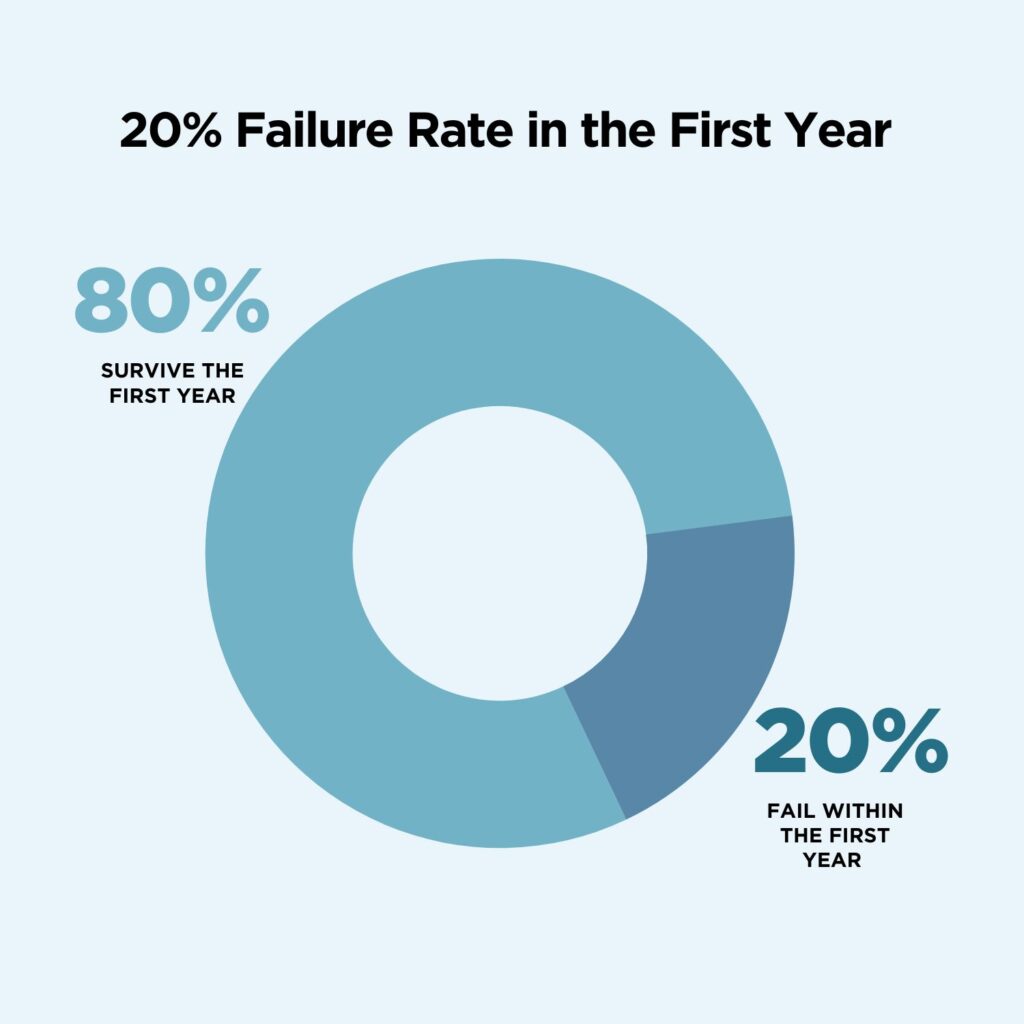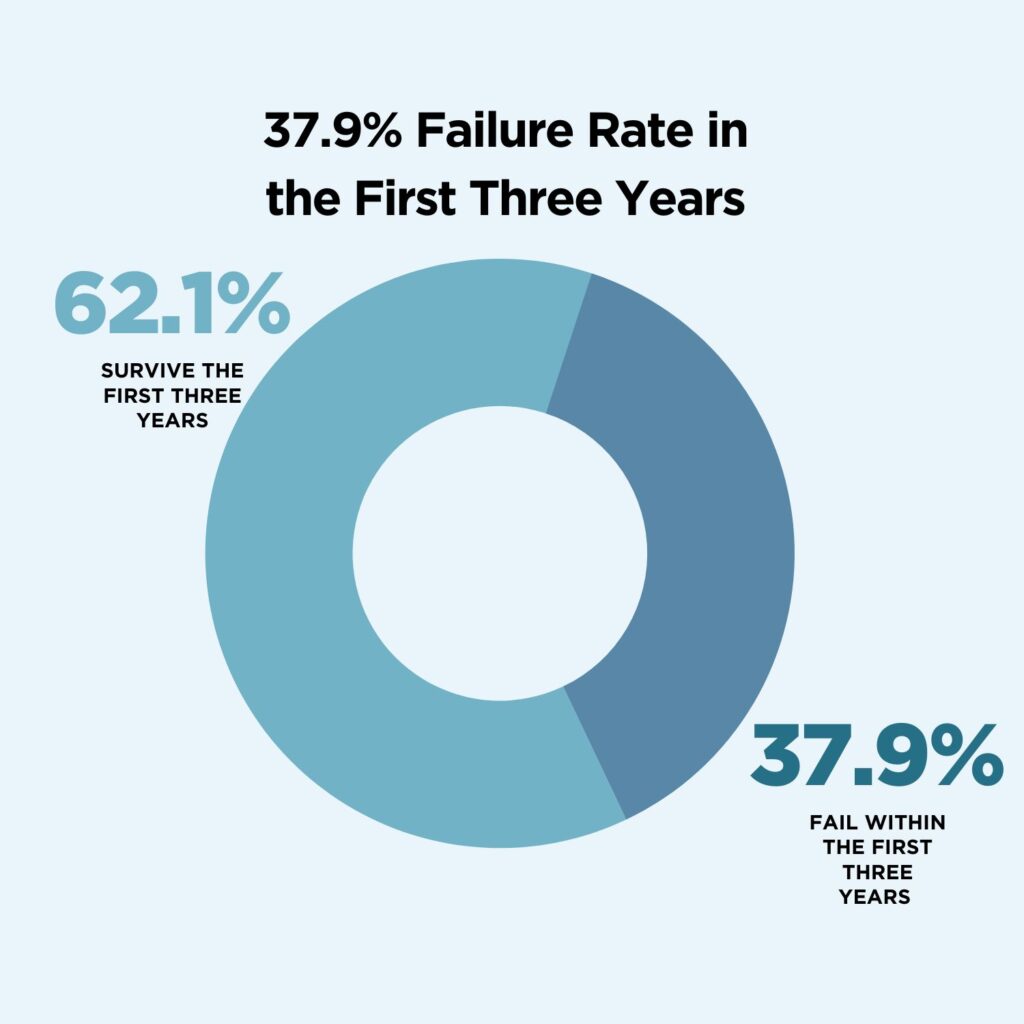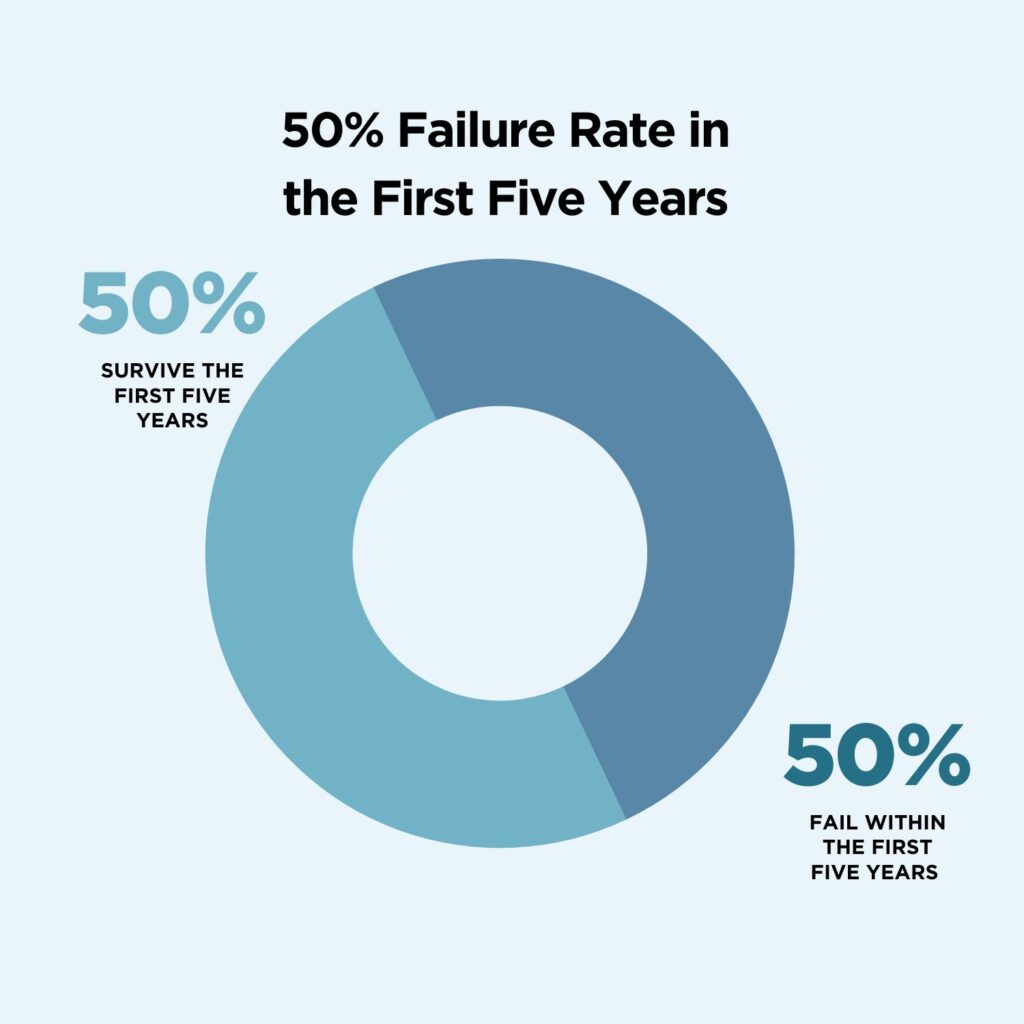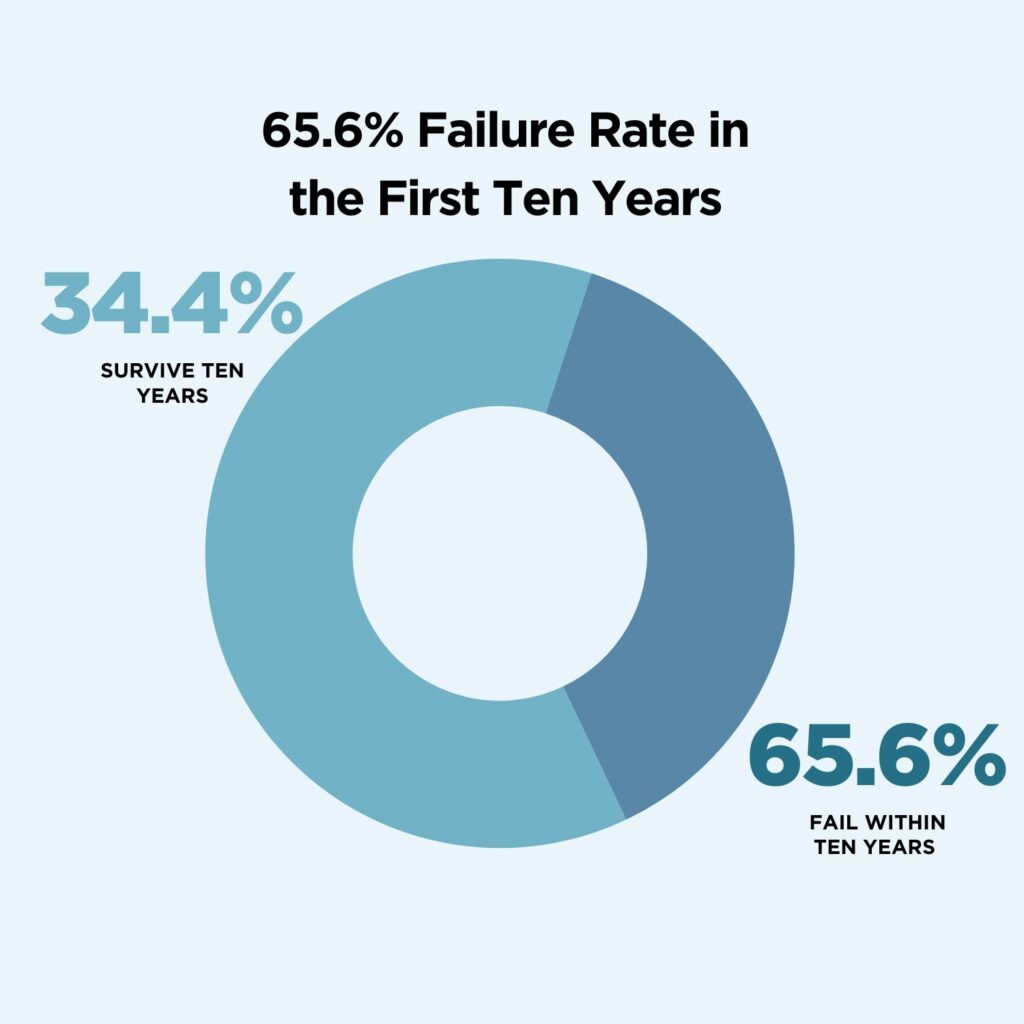Why do 90 percent of businesses fail? Is that fact even true? You’re about to find out thanks to these business failure statistics.
Millions of new businesses are launched each year, but only a portion of them survive. Why do so many businesses fail year after year? Well, that is what we are exploring in this article.
Business statistics and failure rates are a smart way to look deeper into the subject. By understanding these figures, you can better understand why businesses close down and, hopefully, avoid these pitfalls yourself.
Scroll on for a robust list of 30 research-backed business failure statistics all gathered from reputable sources. Ready to not fail? Let’s get started.
Top business failure statistics
- 18.4% fail within the first year
- 49.7% fail within the first 5 years
- 65.6% fail within the first 10 years
- Only 25% make it beyond 15 years
What percentage of businesses fail?
There are countless reasons why various businesses fail. When thinking about all of the new startups, local small businesses, large enterprises, and VC-backed unicorns—what percentage of them fail? In short, the vast majority.
To kick things off, let’s uncover just how many businesses are started each year and are replacing those that fail before them.
1. There are currently over 32.5 million small businesses in the United States
(U.S. Small Business Administration)
At the end of 2021, there were over 32 million small businesses within the United States. The SBA considers these firms with fewer than 500 employees. Small businesses make up 99.9% of all U.S. businesses and are a powerful driver of the economy and employment. With an estimated 61.2 million small business employees, these firms make up almost half (46.8%) of America’s workforce.
2. Every year, more than 600,000 new businesses are started
(U.S. Small Business Administration)
Business failure rates may be high, but many new businesses are launched daily to quickly replace—and outnumber—those that shut down. The SBA estimates that more than 600,000 new businesses are launched every year. From March 2019 to March 2020, 1 million new U.S. establishments opened while 993,809 closed. That was a net positive increase of over 42,000 new small businesses.
Do 90% of businesses fail?
Not quite, let us explain. The failure rates of businesses show that around 20% fail in their first year and about half of businesses are still standing after 5 years. Certain startups, however, tend to have a 90% failure rate and somehow, this statistic became the norm.
3. 90% of disruptive startups fail
(Nanoglobal)
Companies classified as startups have a higher failure rate because of their forward-thinking and potentially disruptive nature. Many startups don’t make it past the ideation phase and without proper funding, fail quickly. This statistic, geared at startups, quickly became widespread as fact. However, this trend doesn’t track with all business types (more on that next).
4. 99.9% of unicorns fail
(Nanoglobal)
Companies earn “unicorn” status once they hit a valuation of over $1 billion without being listed on the stock market. This is the dream of any tech startup, but, all of that capital doesn’t increase their chances of success. Only 0.00006 of unicorn companies make it. Some examples of the rare unicorns that did succeed include SpaceX, SHEIN, Canva, Revolut, and OpenSea.
What percentage of businesses fail in the first year?
5. Almost 20% of businesses fail within their first year
(Lending Tree & SBA)
A whopping 18.4% of businesses fail in less than 12 months of being open. One in five businesses is predicted to fail within their first 18 months. Following the trend line, this business failure statistic rises to 30.6% after two years.

6. Over 25% of Hawaiian businesses fail in their first year
(Lending Tree & SBA)
Of the 50 states in America, Hawaii tops the list with the highest first-year business failure rate. Over a quarter (25.4%) of new companies started in this tropical state fail in less than 12 months. The next highest state failure rates are D.C. (25.1%) and Kansas (23.2%). Washington has the lowest first-year business failure rate at just 10.9%.
| State with highest failure rates | % of businesses |
| Hawaii | 25.4% |
| D.C. | 25.1% |
| Kansas | 23.2% |
How many businesses fail in the first 3 years?
7. 37.9% of new American businesses fail in the first three years
(Lending Tree & SBA)
Surviving the first year is hard work, but statistics prove that it doesn’t get easier three years in. A little more than six in every 10 businesses make it to celebrate their three-year anniversary, meaning 37.9% will fail in this time frame.

What percentage of businesses fail in the first 5 years?
8. About 50% of all new businesses will fail within 5 years
(Lending Tree & SBA)
The SBA reports that 49.7% of businesses will fail in half of a decade. Historically, these statistics have stayed consistent since the 1990s, even despite the recent COVID-19 pandemic. So in short, businesses have a 50/50 chance of survival in 5 years.

What percentage of businesses fail in the first 10 years?
9. 65.6% of businesses fail by their tenth year in operation
(Lending Tree & SBA)
Only about 34% of small businesses will make it to their 10-year anniversary. Surviving 15 years or more is something that just one-quarter (25%) of American businesses do.

What percentage of companies survive 50 years?
It’s hard to determine what percentage of companies survive over half of a century, but here are some statistics that help explain how rare this accomplishment truly is.
10. Many of today’s “popular” companies are less than 20 years old
(Washington Times)
Facebook (2004), Google (1998), and Netflix (1997) are about halfway to 50 while transportation disrupters like Lyft (2012) and Uber (2009) are closer to just a decade old. Microsoft, founded as early as 1975, is still 3 years away from 50.
11. Only one-third of family-owned businesses survive to the second generation
(Washington Times)
Many long-standing, successful businesses are family operated and passed down to their future generations. However, only one-third of businesses make it to the next generation. Even less, only 12%, make it to the third generation.
What percentage of businesses fail in the US due to shoplifting?
12. 30% of business failures are caused by employee theft
(Coverlink & Better Business Bureau)
Shoplifting is a huge problem for businesses, especially because many crimes happen internally. According to the Better Business Bureau, 30% of failed businesses are due to employee theft or embezzlement. Why? This high rate is due to the fact that small businesses typically run on thin margins and can’t account for these losses.
13. Shoplifting cost US retailers $62 billion in 2019
(Business Insider)
Theft is a rising problem within the United States amounting to $62 billion in 2019. That figure was $11 billion more than the previous year. The losses incurred from shoplifting (called “shrink”) represented approximately 1.6% of all sales.
What is the #1 reason that businesses fail?
14. 82% of businesses experience or fail because of cash flow problems
(Business Insider)
What’s the #1 reason that businesses fail? Money, or tangentially, cash flow problems. More than 8 in 10 businesses admit to experiencing cash flow problems at some point during their operations. To sum it all up, a study revealed that 82% of businesses fail because of cash flow mismanagement. If money is not managed properly and strategically, it causes impossible-to-fix chronic problems.
15. 38% of businesses fail because they run out of cash
(CB Insights & Lending Tree)
The top reason that new businesses fail according to a recent survey was that they simply ran out of cash and were unable to raise new capital. Even a profitable business can easily cause its own demise if it begins to scale without enough funds or a proper business plan and budget.
According to another survey from LendingTree, 25% of Americans wanted to open a business last year. However, of these, 40% admitted they didn’t have enough money to do so, further proving this top business failure reason.
16. 35% of businesses fail because there is no market need
(CB Insights)
Studies revealed that 35% of startups fail by developing an irrelevant product in their current market. This is caused by startups not conducting the proper market research and/or establishing an MVP (minimum viable product) to test their product fit.
Another contributor to the lack of demand was the COVID-19 pandemic. As the world changed its habits, businesses found themselves pivoting online or creating new products to fit new needs.
17. 20% of businesses fail because their competition overtakes them
(CB Insights)
The third largest reason that 20% of companies fail is not keeping up with their competition. It doesn’t help that about 14% of small businesses admit to having trouble with marketing, a key contributor to beating one’s competitors. Small businesses may have an innovative idea to bring to market, but it’s simple for larger companies to mimic their offering and deliver it on a larger scale. In short, competition is the reason for one-fifth of all business failures.
18. 21.9% of small businesses close down because owners retire
(SBA)
Just because a business closes down, it doesn’t necessarily mean that it failed. Over 20% of businesses close up shop because their owner chose to retire. Meanwhile, 20.3% sell the business to someone else, and 6.3% close because the owner decided to start a new business.
More contributing reasons to businesses closing are considered “personal.” 4.7% of businesses fail due to illness or injury, 3.1% due to a death, and 1.6% because of personal credit reasons.
| Reason for closing a business | % of businesses |
| Sell their business | 20.3% |
| Retirement | 20% |
| Start a new business | 6.3% |
| Illness or injury | 4.7% |
| Death | 3.1% |
| Personal credit reasons | 1.6% |
Business failure rate by country
Are you curious about this topic on a global scale? Let’s explore statistics sharing business failure rates comparing some of the world’s largest countries and regions.
19. In the US, the average annual rate of business failure is 12.72%
(Shopify)
What is the annual business failure rate of American companies? According to Shopify, the world’s leader in eCommerce businesses, the average annual business failure rate from 2017 to 2021 was 12.72%. What does that mean? For every business that started in 2016, almost 13% more of them fail with each passing year.
20. On average, 35.1% of SMEs in Canada survive at least 16 years
(Government of Canada)
Canada has a business failure rate similar to the United States in that about 35% of small to medium-sized enterprises stay in business for at least 16 years. This business failure statistic refers to the goods-producing sector. For service-based businesses, just 29.6% of these SMEs last the same period of time.
21. Businesses in the United Kingdom have a one-year survival rate of 88.3%
(Statista)
That means new businesses located in the United Kingdom have a higher survival rate than American companies (where roughly 20% fail) during their first year. What’s the business failure rate for UK businesses long term? An estimated 39.6% of UK-based businesses survive for over 5 years.
22. Greece has the highest one-year business survival rate in Europe at 96.7%
(Business Insider)
The European Union has a similar business failure rate as the United States. Almost one in five new businesses within the EU fail during their first year. However, Greece performs much better and tops the list with an impressive 96.7% survival rate. Second place goes to Sweden, then the Netherlands, then Belgium.
The countries in the EU with the lowest one-year survival rates are Lithuania at just 63.6%. Other countries at the bottom of the list and with the highest chances of failure include Portugal, Denmark, and Poland.
23. An estimated 29% of businesses in South Korea survive over 5 years
(Statista)
Based on figures from 2019, the average five-year business failure rate in South Korea is 71%. Just 65% of new businesses in this Asian country survive their first year. In year two, just 49.5% of businesses survive. To see year three, another 42.6% fail before this.
24. 80% of businesses in Africa fail within their first five years of existence
(Business Day Nigeria)
Africa has the highest entrepreneur rate in the world according to a Nigeria MSME report. However, approximately 80% of micro, small, and medium-sized businesses throughout Africa will fail within their first half-decade.
That means a mere 20% of African businesses survive long term. Why? One report discovered that 22% of Africa’s working-age population start businesses but lack the necessary resources and capital to be successful.
25. 60% of new businesses in Australia fail within their first three years
(Fundsquire)
Down under in Australia, new businesses have a high failure rate too. About 20% of Australian new businesses fail their first year, then 60% go belly up within their first three years. These numbers fluctuate greatly based on their sector. The transport industry has a 45.7% three-year survival rate, while agriculture only has a 7-8% failure rate.
Business failure rate globally
26. In 2021, there was an estimated 333.34 million companies worldwide
(Statista)
How many companies exist worldwide? According to research, there were about 333.34 million as of last year. This is slightly more than in 2019 and 2020 when there was an estimated 328 million companies globally. So, what’s the grand total and business failure rate globally?
27. Globally, businesses failure rates are between 20-40%
(OECD)
A report surveying businesses from May to October 2020 revealed that on a global scale, business failure rates ranged from 20-40%. In many regions since then, SMEs in all regions have experienced gradual improvement since these pandemic years. However, this recovery rate has slowed substantially.
Business failure rate by industry
28. What industry has the highest failure rate?
(Chamber of Commerce)
The industries with the highest failure rates are the construction, transportation, and warehousing industries where 30%-40% of businesses fail within their fifth year.
Business success rates
Are these statistics making you think twice about starting your own business? Don’t be discouraged. The majority of businesses are profitable!
29. 65% of business owners report being profitable
(Guidant Financial)
While many businesses fail each year, the majority of them are profitable. A survey in early 2022 showed that 65.3% of small businesses are making money and are profitable. About half of this survey’s respondents represented newer companies 5-years-old or younger, too!
30. New businesses have an 81.6% chance of succeeding in their first year
(Lending Tree & SBA)
Let’s reverse the business failure rates to look at the possibility of success. New businesses have an 81.6% chance of surviving their first year. Four in five businesses will succeed to make it past their first 18 months. In two years, a little less than 70% of businesses are still standing.
Frequently asked questions
What is the percentage of businesses that fail?
Almost 20% of businesses fail within the first year and 65.6% fail before the tenth year mark. The average business lasts eight and a half years.
What industry has the highest failure rate?
Transportation, construction, and warehousing have the worst failure rates with 30%-40% of these businesses surviving five years, while approximately 50% of all businesses make it to their fifth year.
Conclusion
What do you think? After reading 30 statistics discussing the percentage of businesses that fail, do you feel discouraged or ambitious? While many new companies don’t have what it takes to survive, there are plenty of businesses that find ways to adapt and survive for years.
What business failure statistic did you find the most interesting? Let us know in the comments.
Read more:
Guide: Start a Business Online
The Benefits of Online Business
Guide: Entrepreneur Mindset Strategies
The Best Online Business Courses
Sources:
U.S. Small Business Administration
Coverlink & Better Business Bureau









3 Responses
Canva is indeed a rare unicorn. I remember when my graphic design employees who were photoshop-crazy were freaking out because it was a better mousetrap – and it’s only gotten better with age. If only I was an investor…haha!
Haha – agreed! 🙂
I sold my business in the UK after 27 years with zero funding from any 3rd party for a 8 figure sum. If I had known the scary statistics in this article I would’ve never started..!!!🤔 only thing I’d say is that if you are committed to 12 hour days and sticking with your best staff, then don’t let the stats scare you. Ah yes and this thing called luck along the way..!!!